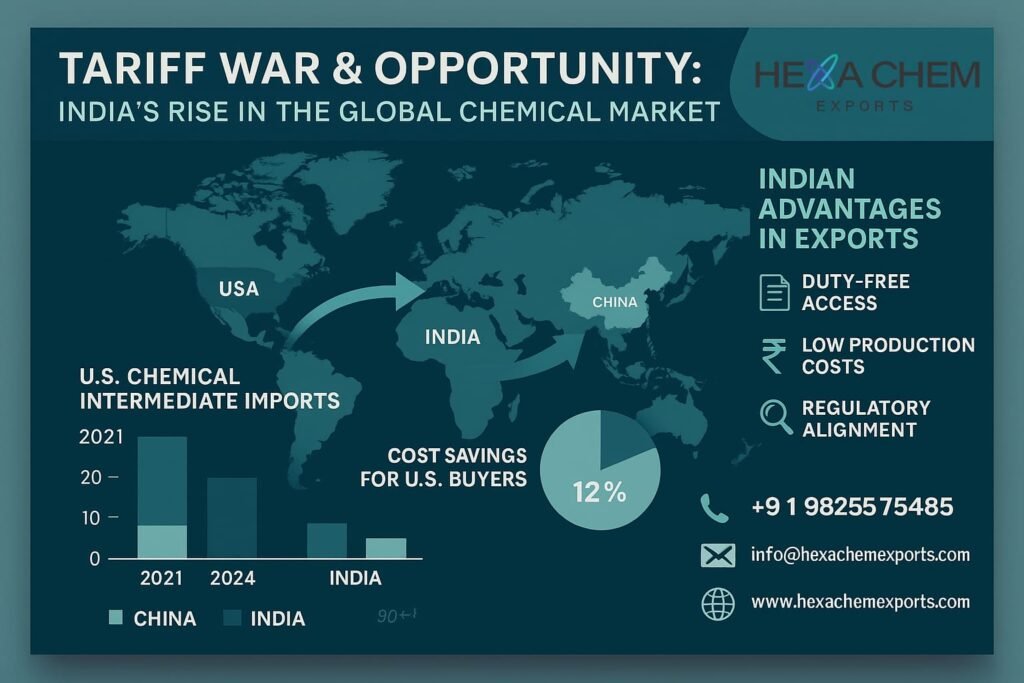- Background: U.S.–China Trade Tensions
- Origins: In 2018 the U.S. imposed tariffs on roughly \$250 billion of Chinese imports; China retaliated on \$110 billion of U.S. goods.
- Chemical Sector Focus: Key U.S. tariffs target intermediate chemicals (e.g., methanol, acetic acid) and specialty polymers; China’s retaliatory duties cover petrochemicals, dyes, and additives.
- Recent Developments (Q1 2025)
- U.S. Adjustment: In March 2025, the U.S. temporarily exempted certain chemical intermediates (e.g., ethylene glycol, propylene oxide) from 25 % duties for six months to ease domestic shortages.
- China Response: Beijing lowered import duties on select pharma APIs (e.g., ciprofloxacin, azithromycin) to stabilize local supply and reduce costs.
- Tariff War Effects on Global Trade
| Category | U.S. Duties on China | China Duties on U.S. | Impact on Others (India) Demand shifts to Indian supplier - India’s Competitive Advantage
- Duty‑Free Access
- Under various U.S. GSP (Generalized System of Preferences) programs, over 75 % of India’s chemical exports enter duty‑free.

- Cost‑Effective Production
- Indian manufacturers benefit from lower feedstock costs (e.g., naphtha, coal‑tar derivatives) and economies of scale in petrochemicals and dyes.
- Regulatory Alignment
- India’s recent alignment of pharma API standards with U.S. FDA and EU EDQM guidelines simplifies market entry.
- Diversified Sourcing
- Buyers in the U.S. and EU are reducing reliance on China, opening long‑term contracts for Indian suppliers of:
- Acetic acid, ethylene oxide,SLS/SLES surfactants
- Ciprofloxacin HCl, Ibuprofen intermediates
- Reactive dyes, optical brighteners, UV absorbers.
- Case Study: Shifting Supply of Ethylene Oxide
- Pre‑Tariff (2021–22): U.S. imported ~45 % of its ethylene oxide from China.
- Post‑Tariff (2024): Chinese shipments fell by 60 %; Indian exporters increased volumes by 150 %, capturing 25 % of U.S. market share.
- Outcome:
- U.S. buyers saved an average 8 % on landed costs by switching to India.
- Indian producers ramped capacity by 20 % and invested $100 million in new reactors.
- Strategic Recommendations for Indian Exporters
- Product Diversification: Develop niche specialty chemicals (e.g., bio‑based surfactants, green solvents) to meet shifting demand.
- Trade‑Finance Solutions: Partner with banks to provide letters of credit and flexible payment terms to importers adjusting to tariff volatility.
- Tariff Timeline: Chart showing U.S. and China tariff hikes since 2018.
- Market‑Share Shift: Bar graph comparing China vs. India exports of key intermediates to the U.S. (2021 vs. 2024).
- Cost‑Savings Analysis: Pie chart of landed‑cost reduction (%) for U.S. buyers switching to India.
HexaChemExports is your trusted partner for high‑quality chemical and pharma intermediates.
📧 info@hexachemexports.com | 📞 +91 98255 75485
🌐 www.hexachemexports.com

